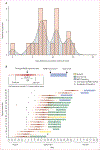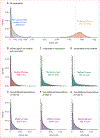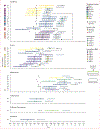Measles virus transmission patterns and public health responses during Operation Allies Welcome: a descriptive epidemiological study
- PMID: 37516478
- PMCID: PMC10411127
- DOI: 10.1016/S2468-2667(23)00130-5
Measles virus transmission patterns and public health responses during Operation Allies Welcome: a descriptive epidemiological study
Abstract
Background: On Aug 29, 2021, Operation Allies Welcome (OAW) was established to support the resettlement of more than 80 000 Afghan evacuees in the USA. After identification of measles among evacuees, incoming evacuee flights were temporarily paused, and mass measles vaccination of evacuees aged 6 months or older was introduced domestically and overseas, with a 21-day quarantine period after vaccination. We aimed to evaluate patterns of measles virus transmission during this outbreak and the impact of control measures.
Methods: We conducted a measles outbreak investigation among Afghan evacuees who were resettled in the USA as part of OAW. Patients with measles were defined as individuals with an acute febrile rash illness between Aug 29, 2021, and Nov 26, 2021, and either laboratory confirmation of infection or epidemiological link to a patient with measles with laboratory confirmation. We analysed the demographics and clinical characteristics of patients with measles and used epidemiological information and whole-genome sequencing to track transmission pathways. A transmission model was used to evaluate the effects of vaccination and other interventions.
Findings: 47 people with measles (attack rate: 0·65 per 1000 evacuees) were reported in six US locations housing evacuees in four states. The median age of patients was 1 year (range 0-26); 33 (70%) were younger than 5 years. The age distribution shifted during the outbreak towards infants younger than 12 months. 20 (43%) patients with wild-type measles virus had rash onset after vaccination. No fatalities or community spread were identified, nor further importations after flight resumption. In a non-intervention scenario, transmission models estimated that a median of 5506 cases (IQR 10-5626) could have occurred. Infection clusters based on epidemiological criteria could be delineated into smaller clusters using phylogenetic analyses; however, sequences with few substitution count differences did not always indicate single lines of transmission.
Interpretation: Implementation of control measures limited measles transmission during OAW. Our findings highlight the importance of integration between epidemiological and genetic information in discerning between individual lines of transmission in an elimination setting.
Funding: US Centers for Disease Control and Prevention.
Copyright © 2023 The Author(s). Published by Elsevier Ltd. This is an Open Access article under the CC BY-NC-ND 4.0 license. Published by Elsevier Ltd.. All rights reserved.
Conflict of interest statement
Declaration of interests We declare no competing interests.
Figures





References
-
- WHO. Measles vaccination coverage, Afghanistan. 2022. https://immunizationdata.who.int/pages/coverage/mcv.html?CODE=AFG&ANTIGE... (accessed April 19, 2022).
-
- WHO. Afghanistan: infectious disease outbreaks situation report #15 (21 November 2021). Nov 22, 2021. https://www.humanitarianresponse.info/en/operations/afghanistan/document... (accessed Dec 20, 2021).
-
- Centers for Disease Control and Prevention. Guidance for clinicians caring for individuals recently evacuated from Afghanistan. Sept 20, 2021. https://emergency.cdc.gov/han/2021/pdf/CDC_HAN_452.pdf 2021 (accessed April 19, 2022).
-
- Katz SL, Hinman AR. Summary and conclusions: measles elimination meeting, 16–17 March 2000. J Infect Dis 2004; 189 (suppl 1): S43–47. - PubMed
Publication types
MeSH terms
Grants and funding
LinkOut - more resources
Full Text Sources
Medical

